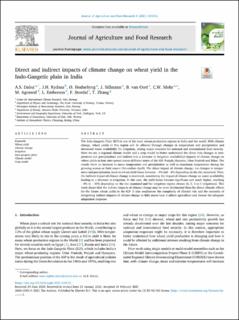| dc.contributor.author | Daloz, Anne Sophie | |
| dc.contributor.author | Rydsaa, Johanne Hope | |
| dc.contributor.author | Hodnebrog, Øivind | |
| dc.contributor.author | Sillmann, Jana | |
| dc.contributor.author | Oort, Bob Eric Helmuth van | |
| dc.contributor.author | Mohr, Christian Wilhelm | |
| dc.contributor.author | Agrawal, Madhoolika | |
| dc.contributor.author | Emberson, Lisa | |
| dc.contributor.author | Stordal, Frode | |
| dc.contributor.author | Zhang, Tianyi | |
| dc.date.accessioned | 2021-12-01T09:50:46Z | |
| dc.date.available | 2021-12-01T09:50:46Z | |
| dc.date.created | 2021-04-21T23:30:11Z | |
| dc.date.issued | 2021-02-28 | |
| dc.identifier.citation | Daloz, A. S., Rydsaa, J. H., Hodnebrog, Ø., Sillmann, J., van Oort, B., Mohr, C. W., … Zhang, T. (2021). Direct and indirect impacts of climate change on wheat yield in the Indo-Gangetic plain in India. Journal of Agriculture and Food Research, 4, 100132. | en_US |
| dc.identifier.uri | https://hdl.handle.net/11250/2832291 | |
| dc.description.abstract | The Indo-Gangetic Plain (IGP) is one of the main wheat-production regions in India and the world. With climate change, wheat yields in this region will be affected through changes in temperature and precipitation and decreased water availability for irrigation, raising major concerns for national and international food security. Here we use a regional climate model and a crop model to better understand the direct (via changes in temperature and precipitation) and indirect (via a decrease in irrigation availability) impacts of climate change on wheat yields at four sites spread across different states of the IGP: Punjab, Haryana, Uttar Pradesh and Bihar. The results show an increase in mean temperature and precipitation as well as maximum temperature during the growing season or Rabi season (November–April). The direct impact of climate change, via changes in temperature and precipitation, leads to wheat yield losses between −1% and −8% depending on the site examined. Then, the indirect impact of climate change is examined, considering the impact of climate change on water availability leading to a decrease in irrigation. In this case, the yield losses become significant and much higher, reaching −4% to −36% depending on the site examined and the irrigation regime chosen (6, 5, 3 or 1 irrigations). This work shows that the indirect impacts of climate change may be more detrimental than the direct climatic effects for the future wheat yields in the IGP. It also emphasizes the complexity of climatic risk and the necessity of integrating indirect impacts of climate change to fully assess how it affects agriculture and choose the adequate adaptation response. | en_US |
| dc.language.iso | eng | en_US |
| dc.publisher | Elsevier B.V. | en_US |
| dc.rights | Attribution-NonCommercial-NoDerivatives 4.0 Internasjonal | * |
| dc.rights.uri | http://creativecommons.org/licenses/by-nc-nd/4.0/deed.no | * |
| dc.title | Direct and indirect impacts of climate change on wheat yield in the Indo-Gangetic plain in India | en_US |
| dc.type | Peer reviewed | en_US |
| dc.type | Journal article | en_US |
| dc.description.version | publishedVersion | en_US |
| dc.rights.holder | © 2021 The Authors | en_US |
| dc.source.volume | 4 | en_US |
| dc.source.journal | Journal of Agriculture and Food Research | en_US |
| dc.identifier.doi | 10.1016/j.jafr.2021.100132 | |
| dc.identifier.cristin | 1905732 | |
| dc.relation.project | Norges forskningsråd: 244551 | en_US |
| dc.relation.project | Norges forskningsråd: 299600 | en_US |
| dc.relation.project | Norges forskningsråd: 244018 | en_US |
| dc.source.articlenumber | 100132 | en_US |
| cristin.ispublished | true | |
| cristin.fulltext | original | |
| cristin.qualitycode | 1 | |

